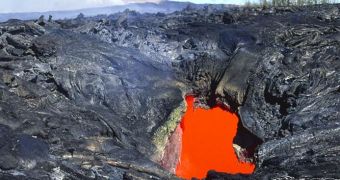A group of researchers presented the results of a new scientific investigation earlier this month, showing for the first time the existence of magma chambers below the surface of the Hawaii Islands, at extremely shallow depths.
The research showed that some of the chambers lie 1.9 to 2.5 miles (3 to 4 kilometers) below the surface, which is extremely close. In fact, these are the shallowest magma chambers ever detected on the surface of our planet.
Details of the investigation were presented on December 14 in San Francisco, at the 2010 annual fall meeting of the American Geophysical Union (AGU), Daily Galaxy reports. The research was showcased by Ohio State University (OSU) expert Julie Ditkof.
During the study, the researcher and her team collected thousands of volcanic rock samples, which were harvested from the most volcanically-active regions of the Hawaii, the Big Island and the Loihi undersea volcano.
When sufficient samples were collected, the researchers conducted a special series of analysis on the rocks, all of which contained the mineral olivine. This is the first mineral to crystallize when temperatures and pressures surrounding lava and magma drop.
Using a technique developed in Iceland by OSU research partner Michael Barton, Ditkof managed to determine the depth at which each of the olivine samples originated.
By analyzing olivine isotopic ratios in each of the samples, the experts were able to determine the depth of the magma chambers each of the sample originate in, and the depth at which the mineral began crystallizing, Daily Galaxy reports.
Previous studies had shown the the shallowest magma chambers in Hawaii were buried some 11 to 25 miles (18 to 40 kilometers) below the surface of the ground. But this was proven false in 2008.
At the time, workers searching for geothermal energy near the Kilauea volcano reported passing through the roof of such a magma chamber. But past studies of minerals painted a different story of the underground.
On the other hand, seismic analysis of the entire area showed that the magma chambers were just some 1.2 to 3.7 miles (2 to 6 kilometers) beneath the surface. “We wanted to prove one right or one wrong,” Ditkof explains.
“Very shallow magma chambers mean there is a very shallow geothermal heat source that could be tapped. If someone could utilize that, you have amazing geothermal potentials,” she concludes.

 14 DAY TRIAL //
14 DAY TRIAL //